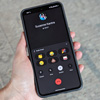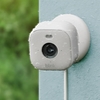Updated on 8/1/2022 with instructions on changing video recording resolution.
With all of the photos and videos we take, many of us run out of space. And, it usually happens at the worst possible time – baby's first steps, a celebrity sighting, hilarious pet antics. So, follow our simple steps to ensure you always have room for that next important shot.
1. Back up your phone to the cloud
If you don’t have the time or patience to sift through old photos and videos, or if you want to keep all your media files, back them up to a cloud storage service and delete those you don't want locally on your phone. With cloud storage services like Dropbox, you can choose to have your photos automatically backed up whenever you have access to WiFi, so you can have a full-resolution copy.
If you use an iPhone, the process is automatic if you've enabled the iCloud automatic backup service.
- Open Settings.
- Select "Apple ID."
- Select "iCloud." Toggle on all of the apps you want to back up to iCloud. If you want your photos and video backed up, select "Photos" and toggle on "iCloud Photos." However, once you turn on iCloud Photos, any action you take on your phone will be replicated in iCloud. So if you delete a photo or video, it will delete in your iCloud backup. If you want to delete photos on your phone, we recommend backing up your phone locally, as outlined below.
- Select "iCloud Backup."
- Toggle on "iCloud Backup." If you already have iCloud backup on, you'll see the last time you backed up to iCloud. If you're short on iCloud storage, go to Settings > Apple ID > iCloud and select "Manage Storage." There you can choose "Backups." If you have old phone backups you don't need, you can delete those to regain space. You should always leave one backup for your iPhone.
If you choose to back up your photos and videos to iCloud, go to Settings > Apple ID > iCloud > Photos and toggle on iCloud Photos. Then select Optimize iPhone Storage. This keeps a lower-resolution version of your photos on your phone and full resolution in iCloud. If you're traveling and on a limited data plan, go to Settings > Photos > Cellular Data and toggle off "Cellular Data" to ensure you don't go over your data plan.
For Android, you can automatically back up your phone to Google One.
- Open Settings.
- Select "Google." If you're concerned about mobile data, scroll down and make sure "Back up using mobile or metered Wi-Fi data" is toggled off.
- Select "Backup." If you have backed up your phone before, you will see a list of what's backed up. If everything is backed up or if this is the first time you're backing up to Google, proceed to the next step. If you don't see everything being backed up, open the Google One app and select "Storage." Then select "View details." Now you can select "Manage backup" to choose the data you want backed up.
- Select "Back up now." If this is your first backup, you will be able to select what you want to be backed up.
For Android and iPhone users, consider Google Photos (for iOS and Android), which can be set up to automatically backup photos and videos over WiFi. To keep full-resolution photos, make sure you select Original as the image quality. Go to Settings > Back up & Sync > Upload size > and choose Original. Google Photos also has a Free Up Space feature that deletes photos you've already backed up to the cloud. For iPhones, you'll need to also delete them from the Photos app (the Apple Photos app). To do that, go to the Photos app, select " Recently Deleted," and delete the photos again.
2. Back up your phone locally
To avoid the cost and limitations of cloud storage, back up your files to your computer. Of course, the downside is that you can only do this when you can access your computer through a wired or wireless connection.
If you own an iPhone and a Mac running MacOS 10.15 or later, you can use the Finder app to back up your iPhone. Open the Finder app and then select General > Back up all of the data on your iPhone to this Mac. You can then choose to encrypt your backup data with a password by selecting "Encrypt local backup." (For earlier versions of MacOS, you can use iTunes. Follow Apple's instructions here.) If you're interested in backing up just your photos and videos to your computer, check out our step-by-step guide on how to download iPhone photos to a computer. You can also use AirDrop to transfer files without having to connect your phone to your computer via a USB cable. If you use a Windows PC, you can use iTunes for Windows. Open iTunes, click on the Device button in the top menu bar, select "Summary," and then click on "Back Up Now."
If you use an Android device, connect your phone to your computer via a USB cable. Your Windows computer should detect your phone as a mass storage or media storage device, and you will be able to drag and drop your photos, videos, and other files from your phone to a folder on your PC. If you have a Mac, install the free Android File Transfer app on your Mac, and then you can drag and drop files onto your Mac.
3. Delete photos and other large files sent in Messages and Email
While it's great to see photos and videos in your messaging app, often, you don't need to keep them. It's easy to find and delete these old files.
For iPhone, go to Settings > General > iPhone Storage > Messages. In the "Photos," "Videos," "GIFs and Stickers," and "Other" folders, you can delete attachments you've sent or received. For other files, go to the Files app and select "On My iPhone." In the "On My iPhone" folder, you'll find folders for all of the apps that save files to the Files app. Look through the files in the folders for large files. You'll see the size of each file below the file name. Delete those files you don't need by pressing and holding the file name until the menu pops up and selecting "Delete."
For Android, open the Files app (also called File Manager). You'll see a folder called 'Downloads." Open the folder, and you'll find all of the files you've downloaded. Pressing and holding a file name will let you select files to delete.
4. Uninstall apps you don't use
While photos and videos are the usual storage hogs, apps (particularly games), can also consume storage space. It’s best to remove apps you don’t use often.
On the iPhone, go into Settings > General > iPhone Storage. You'll see a list of apps sorted by the amount of storage space used. When you select an app, you'll have the option of deleting it or offloading it. Offloading an app will remove the app but leave the data behind in case you want to reload the app at a future date. You can also choose to automatically offload any apps you haven't used in a while. Go to Settings > App Store and toggle on "Offload Unused Apps."
On Android, go to Google Play Store > Profile icon > Manage apps & devices > Manage. Under each app name, you'll see the amount of storage it uses. To delete an app, tap the app name and then tap "Uninstall."
5. Shoot lower-resolution videos
Many of today's higher-end phones can capture videos in up to 8K resolution. These high-resolution videos are clearer and have finer detail, especially if you view them on a 4K or 8K-capable TV or monitor. But, higher resolution video takes up much more storage space than HD videos. If you don’t need 8K or 4K videos, set your camera to capture images at a lower resolution to save storage space.
For iPhones, go into Settings > Camera > Record Video and select 1080p HD at 30 fps, or to save even more space, select 720p HD at 30 fps.
For Android phones, the option to change the resolution will depend on your phone. For Samsung phones, open the Camera app and select Video. In the top navigation, you'll see video resolution. Tap on it the change it. For Google Pixel phones, open the Camera app and select Video. In the top navigation, tap the down arrow next to the video resolution to bring up the menu to change it. For other phones, it can be as simple as opening the Camera app Settings menu.
[Image credit: iPhone showing iPhone storage via Techlicious/Smartmockups]
For the past 20+ years, Techlicious founder Suzanne Kantra has been exploring and writing about the world’s most exciting and important science and technology issues. Prior to Techlicious, Suzanne was the Technology Editor for Martha Stewart Living Omnimedia and the Senior Technology Editor for Popular Science. Suzanne has been featured on CNN, CBS, and NBC.















From Kristi on April 25, 2019 :: 2:35 pm
How do I get rid of or cut down on the storage used by Other in my iPhone storage? This takes up the most space on my iPhone and I don’t know what it is. I have Googled this and have not been able to find a clear cut answer for what Other is or how to get rid of it.
Reply
From Suzanne Kantra on April 25, 2019 :: 3:26 pm
Apple defines “Other” storage as system files, software updates, Siri voices, cached files, logs, and more. It’s everything that’s not Apps, Photos/Videos, Media (music, podcasts etc), Mail, Books, Messages and iCloud Drive content (files and other stuff you’ve downloaded).
How many GB of the total GB of storage are being used?
Reply
From Kristi on April 25, 2019 :: 4:21 pm
7.99 GB of 16 GB.
Reply
From Jorge on April 12, 2020 :: 12:31 pm
is it ok to reset other storage?
From Hossain Mohammad Sujon on May 06, 2023 :: 6:49 pm
My Facebook id password breakup login on open my page
Reply